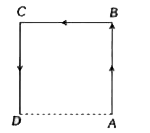A particle P moves with speed .v. along AB and BC, sides of a square ABCD. Another particle Q also starts at a and moves with the same speed but along AD and DC of the same square ABCD. Then their respective changes in velocities are Solution in Telugu
equal in magnitude but different in direction
different in magnitude but same in directions
different both in magnitude and direction
same both in magnitude and direction
The correct Answer is:A
Step by step video, text & image solution for A particle P moves with speed .v. along AB and BC, sides of a square ABCD. Another particle Q also starts at a and moves with the same speed but along AD and DC of the same square ABCD. Then their respective changes in velocities are by Physics experts to help you in doubts & scoring excellent marks in Class 12 exams.
Updated on:21/07/2023Similar Questions
ABCD একটি বর্গক্ষেত্র ও তার বাহুর দৈর্ঘ্য a, AB ও AD বাহুকে যথাক্রমে x ও y অক্ষ ধরে ABCD বর্গক্ষেত্রের পরিবৃত্তের সমীকরণ নির্ণয় করো|
View Solutionएक कण 25 m भुजा वाले वर्ग की भुजाओं AB, BC, CD के अनुदिश 15ms−1 के वेग से गति कर रहा है। इसका औसत वेग हैं।

View SolutionA particle P moves with speed 'v' along AB and BC, sides of a square ABCD. Another particle Q also starts at A and moves with the same speed but along AD and DC of the same square ABCD. Then their respective changes in velocities are
View SolutionA particle P moves with speed .v. along AB and BC, sides of a square ABCD. Another particle Q also starts at a and moves with the same speed but along AD and DC of the same square ABCD. Then their respective changes in velocities are
View SolutionA particle P moves with speed .v. along AB and BC, sides of a square ABCD. Another particle Q also starts at A and moves with the same speed but along AD and DC of the same square ABCD. Then their respective changes in velocities are
View SolutionA particle moves along the sides AB,BC,CD of a square of side 25m with a velocity of "15ms^(-1).Its average velocity is
View SolutionFour particles A,B,CandD are situated at the corner of a square ABCD of side a at t-0. Each of particles moves with constant speed (v). A always has its velocity along AB,B along BC,C along CD~andD along DA. At what time will these particles meet each other ?
View Solution
